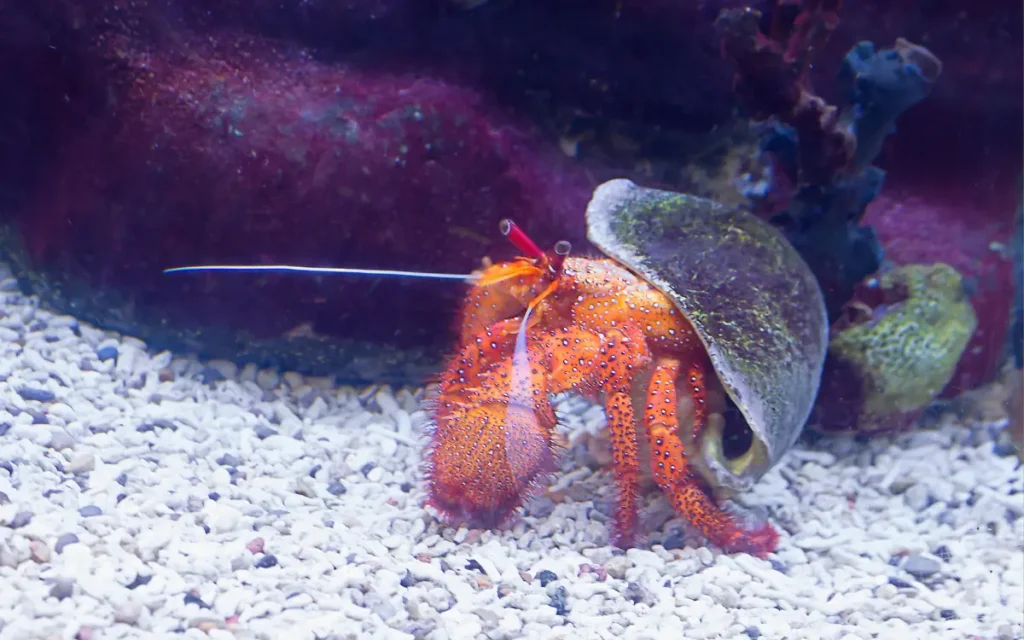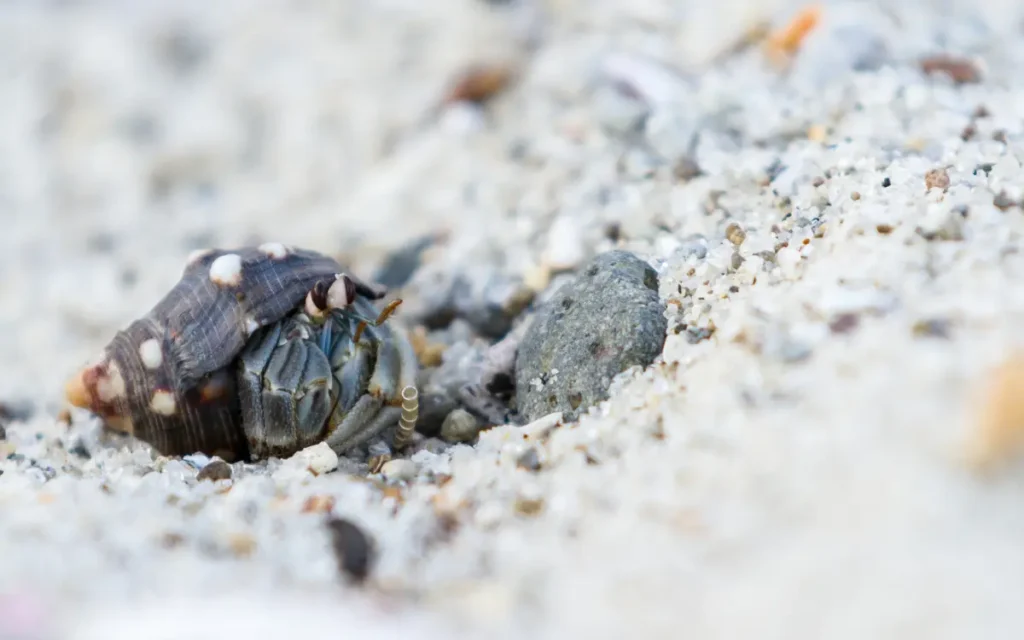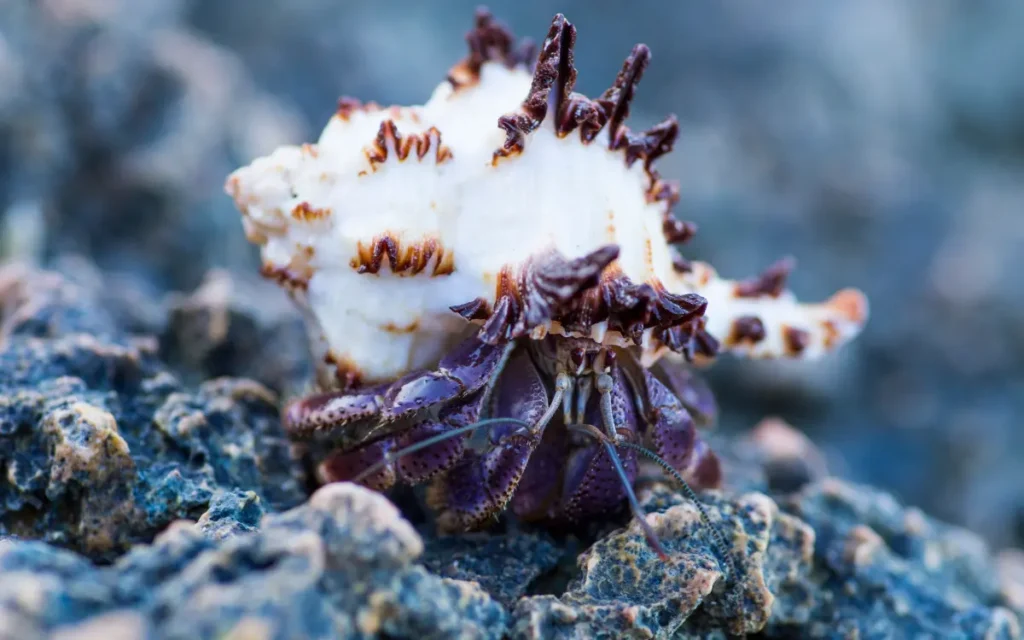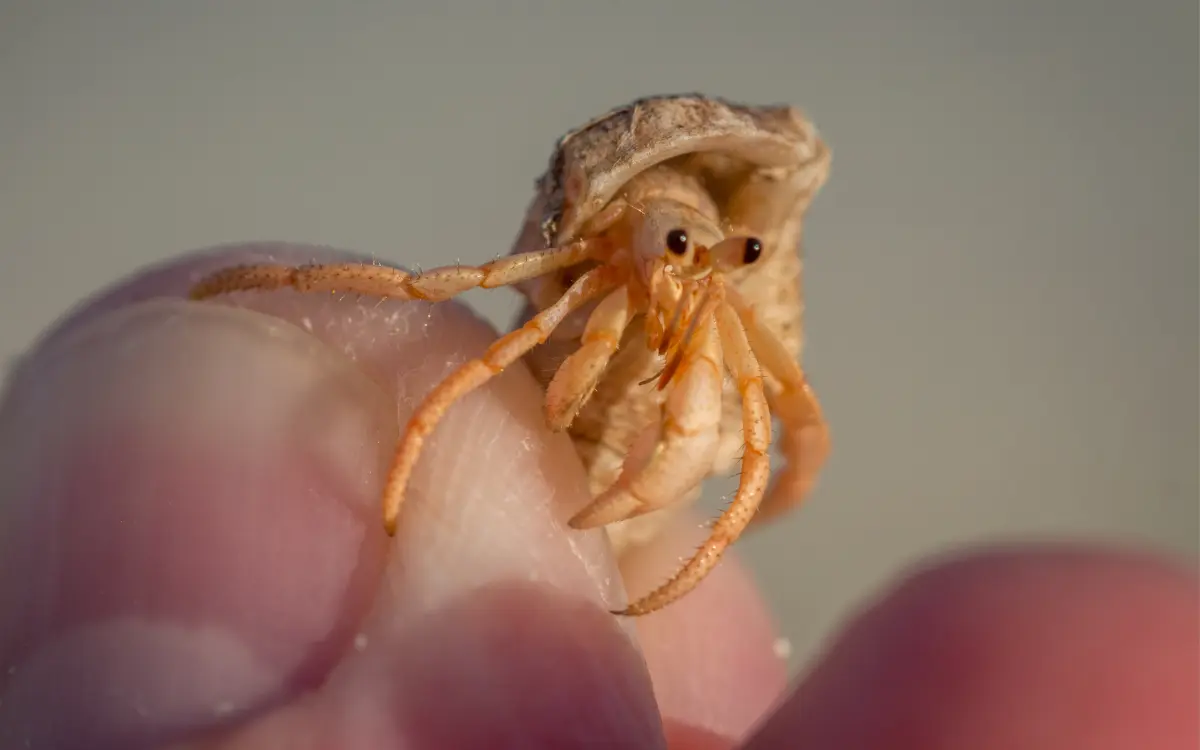Hermit crabs are lovely pets that require proper care, emotionally and physically. They need attention from owners and require multiple hermit crabs as friends. Moreover, they can only live 20 years longer with appropriate food, shelter, shells, water, dry land, sand, and gravel. Also, hermit crabs start fighting and feel suffocated in smaller aquariums. Could you keep them in larger aquariums?
Do you know hermit crabs are the more widely preferred pet of any other creatures for aquariums? These crustaceans do not burden the aquarists because they require low maintenance. However, don’t take low maintenance as “NO MAINTENANCE.” These cute hermies need primary care and maintenance.
In this article, I will touch on every tip to help you keep these critters healthy and happy. Just read on to get insights about caring for a hermit crab.
How to Take Care of a Hermit Crab?

Hermit crabs are always number one on the list if you are looking for a beautiful pet. Have you ever wondered why? The reason is simple – ‘hermies are easier to look after than other aquatic and land pets.’
Before indulging deeper into the topic, look at a few crucial things below!
Things You Should Know!
- Hermit crabs can’t live in loneliness. This is because they are social animals. They survive and thrive in environments where many other friends (hermit crabs, other types of crabs, peaceful fishes, and other aquatic creatures) live with them.
- To keep your hermit crabs healthy, wealthy, and wise, adjust the humidity and temperature of their habitat. The humidity level should be at least 75%. Plus, the temperature should range from 75°F to 85°F ( (24–29 °C). Remember, both of these requirements should be met at any cost and at all times.
- Remember to fill the habitats of your hermies with empty shells, play sand of children, coco fiber, freshwater moss, climbing toys, and saltwater.
Now, let’s come to the methods or proper ways of taking care of your favorite hermit crabs.
Method 1: Set Up a Healthy Habitat:

This is the first and foremost method of how to take care of a hermit crab. Make sure you fulfill all of the requirements for setting up a healthy habitat mentioned before.
1.Tank Size and Number of Crabs:
Use a bigger glass tank or aquarium to keep your hermit crabs in that tank safely. A tank with 38 L gal space (10 US gal) is good enough for one or two hermit crabs. So, according to the math, 6 hermit crabs will require space of 110 L (30 US gal).
Furthermore, there must be humidity inside and outside the homes of hermit crabs. However, their homes must be in the fresh air. That’s why I recommend reptile aquariums or fish tanks because these tanks can do it nicely.
- Larger-sized hermit crabs feel happier in larger tanks than ordinary (necessary) ones.
- Hermit crabs are fond of moving and finding new places in their habitat. So, the larger the space, the better they’ll live.
- I know some guys are really short on materials. Theoretically, they can keep their pet hermit crabs in a big plastic bin.
Quick Tip:
You can use the old leaking tank that is residing in your attic. Just rinse out that and keep your hermies in that. You can also try Acrylic terrariums to keep these creatures in a limited but adequate space.
2. Maintain Humidity Level:
As I have mentioned above, always try to maintain the humidity level of the habitat of hermit crabs at 75%. But the question is, how do you check the humidity level? You can try a hygrometer, a humidity gauge that checks the humidity level.
All you need to do is to stick the hygrometer in the habitat of hermies. If you see that their humidity is getting low, immediately mist their cages with the help of water. They require humidity to breathe properly because they have hardened gills.
They can’t survive longer if the air is not humid. You can say, “Humidity is their friend.” Consider the following to take care of your cuddly hermit crab:
- Add an adequate quantity of natural moss to the aquarium of hermit crabs. It is a perfect way to increment the humidity naturally. Plus, hermit crabs can snack on the natural moss, increasing their appetite to eat healthy.
- many aquarists prefer to use damp crab sponges to increase humidity. However, I don’t recommend my friends and readers to use crab sponges.
Let’s see another follow-up tip for caring for hermit crabs in the below section.
3. Balance the temperature (75–85 °F (24–29 °C)):
Just like the humidity, balancing the temperature of the habitat of hermit crabs is also very important. Just think about it – hermies are tropical animals that love warm temperatures. It must be within the range of 75–85 °F (24–29 °C).
To monitor the temperature effectively, attach a tank thermometer to the home of the hermit crabs. Under-tank heaters are also available to keep the temperature perpetually warm. Alternatively, you can set the aquarium of hermies in a warm place in your home.
Fun Fact:
Do you know heat damage in hermit crabs is irreversible? Maintaining a stable temperature is crucial for crabs because low temperatures can slow down their metabolism.
4. Add Substrates:
You can add substrates like cocofiber and kid’s playsand inside the habitat of hermit crabs. Hermit crabs are known as diggers, and they love to dig in or under the substrates. So, keeping the digging habit of crabs in mind, you can pick anything that is safe and fine with them.
You have two excellent options: play sand designed for small children, coconut fiber, or a mix of both. However, ensure that the bottom of your tank is covered with the substrate.
- Many crabs also enjoy burying and even molting in damp reptile moss.
- Strive to maintain a substrate depth that is three times the height of your largest crab. Therefore, if you estimate your largest crab to be 3 inches (7.6 cm) tall, ensure the substrate depth is 9 inches (23 cm).
5. Set Some Colorful Climbing Toys:
Climbing is one of the favorite activities of hermies. In the wild, hermit crabs climb large rocks exposed during low tide to forage for food. They are occasionally called “tree crabs” because they know how to climb trees to consume insects and vegetation.
However, avoid painted toys, as they can be toxic to the health of the hermit crabs. According to the Hermit Crab Association report, I found the following interesting facts:
- Natural rocks and seashells picked up from the beach are great for the crabitat. Clamshells make excellent food dishes after boiling them in water to sterilize.
- Plastic plants designed for reptiles provide great climbing and hiding spots for crabs. However, remember to use a lid on your tank to prevent the crabs from climbing out.
- According to the study of Crab Street Journal, always avoid the use of reptile “half pine logs” since pine can be irritating and toxic to crabs.
6. Provide Plenty of Hiding Spaces:
You can share respect and care for your hermit crabs by providing plenty of hiding places. Hermit crabs like to hide and seek, requiring a vast space to feel safe. Moreover, they feel threatened in open places.
So, you can use the following things to offer them hiding places or spaces:
- Half coconut shell
- Broken pots
- Large shells
- Small buckets.
Thus, there are many things that you can offer to them. Just be careful that the crab does not get stuck inside the things. If they are stuck, immediately remove that thing from their place.
7. Add Some Live Plants:
If you genuinely care about your hermit crabs, add some live plants in their aquarium or habitat. According to the research of the Crab Street Journal, here are a few suggested live plants that are safe for hermies:
- Real Bamboo
- Venus fly traps bromeliads
- Spider plants
- Pothos.
Be forewarned! The chances are your hermit crabs will snack on your live plants. I’m not going to guarantee that they will grow. If you are not interested in adding live plants because hermit crabs snack on them, you can add beautiful, brightly colored decorations.
8. Provide Freshwater and Saltwater Separately:
The beauty of hermit crab 🦀 care flourishes when you provide them fresh and saltwater in two separate water dishes. Moreover, hermit crabs regulate water salinity in their shells. So, ensure the dishes are deep enough to fill their shells.
Furthermore, you can create a sloping water area: shallow for easy climbing and deep for submersion. This setup allows them to access water while maintaining balance. The researchers at the Hermit Crabs Association state the following considerable facts:
- Do not use tap water for hermit crabs. Use bottled spring water or boiled tap water before giving it to your crabs to avoid harmful minerals and chlorine.
- When preparing saltwater for your crabs, opt for marine fish salt rather than table salt intended for human consumption and use. This is because anti-caking agents in table salt can be harmful. You should aim for a ratio of 1.5 teaspoons (8 grams) of marine fish salt for every 1 cup (1/4 liter) of water to achieve the appropriate salinity level.
Read more about How To Set Up A Crabitat
Method 2: Caring for Your Crabs:

Apart from the tips mentioned above to care for your hermies, do the following to keep them healthy:
1.Replacement of Substrates After 6 Months or So:
Unclean substrate can result in mold growth! It poses a threat to your hermit crabs’ well-being. So, always replace the substrate every six months or whenever you notice a questionable odor in their habitat.
Replace the substrate immediately if you observe mold or detect a mite infestation. During substrate cycles, spot-clean any dung and food debris the crabs have scattered or buried.
Important Note: Refrain from cleaning the substrate when your hermit crab is molting, as disturbing or moving a molting crab can be harmful.
2.Handle Hermies with Extreme Patience and Care:
Do you know hermit crabs show twitchy behavior whenever someone touches them? So, petrol lovers should drive slowly. When your hermies are new in the tank or you have just changed their habitat, you should leave them inside the tank for a week or ten days. Don’t touch them!
After some time, they will stop shying and explore new things, especially your hands, when you offer them. Moreover, don’t give them sudden movements, as most hermit crabs do not tolerate it if you touch them.
Did You Know? When you take them home for the first time, hermit crabs face a “de-stressing” phase for a few days or even a month. The changed food, water, and habitat disturb them a lot. Some of them even suffer from trauma due to changing their home.
3.Let Them Molt:
Hermit crabs need undisturbed peace during one of the vulnerable stages of their lives – molting. So, it’s your responsibility not to disturb them when they are molting. You can’t imagine that most pet hermies die due to stress and anxiety just because their owners disturb them during the molting process.
Essential research by the National Zoo Institute, when the exoskeleton of the hermies tightens, the molting process helps them to grow again. They behave like they are sick, but they are fine in reality. Just give them an extra isolated tank, let them dig, and stay under the substrates until their molting process is over.
Don’t miss out on watching this YouTube video from Dr. Mark Mitchell on hermit crab care and setup guide.
Read also: Hermit Crab Food List: Nutrition Guide For Beginners
FAQs:
Why hermit crabs make good pets?
- Low Maintenance: They require less daily care compared to traditional pets.
- Interesting Behavior: Their unique behaviors, like changing shells and burrowing, are fascinating to observe.
- Small Space Requirements: Hermit crabs don’t need a large habitat, making them suitable for small living spaces.
- Educational: Caring for hermit crabs teaches responsibility and provides a hands-on learning experience about marine life.
- Long Lifespan: With proper care, hermit crabs can live for several years.
- Low Cost: The initial setup and ongoing costs are relatively low.
Is it Bad or an Act of Cruelty if We Keep Hermit Crabs as pets?
Hermit crabs are not “starter pets” or mere decorations. In fact, they should not be treated as such. It’s essential to keep them away from kids and other pets if they are to be kept as pets.
These brilliant and empathetic creatures thrive in their natural habitat. Unfortunately, many buyers struggle to provide the desired and dream life that hermit crabs expect. Pet hermit crabs often have a short lifespan without proper care as they struggle to adapt and thrive in captivity.
Should hermit crabs live alone to live longer?
No! Absolutely NOT. Hermit crabs are social animals. They don’t live alone. Instead, they live together in thousands.
However, many aquarists prefer to keep one hermit crab in the startup. It’s easy for them to pay full attention to that one pet. It’s not recommended; it depends on the preferences of the aquarists and hermit crab enthusiasts.
Do hermit crabs need friends to live a happy life?
Obviously yes, hermit crabs need friends to live a happy life. To prevent loneliness in their lives, you should either give them proper attention or add another hermit crab to the tank. In this way, two crabs will stay busy enjoying their lives.
Why is my hermit crab not moving and eating ?
If your hermit crab is not moving, it could be due to several reasons:
- Molting: Hermit crabs often stay still for weeks during the molting process.
- Stress: Changes in the environment or excessive handling can cause stress.
- Illness: Poor health or improper living conditions can make them lethargic.
- Temperature and Humidity: Hermit crabs need a warm, humid environment (75-85°F and 70-80% humidity).
How to improve their health:
- Change tank water regularly: Provide fresh, clean water.
- Maintain proper conditions: Keep humidity at 70-80% and temperature at 75-85°F.
- Offer fresh, hygienic food: Provide a variety of fresh fruits, vegetables, meat, and hermit crab food daily.
- Ensure a clean habitat: Regularly clean the tank and provide enough space for exploration.
I got a new hermit crab, but it won’t come out of its shell. What should I do?
Dear, don’t do anything! It’s their normal behavior. They’ll come out of their shell after a week or two.
My hermit crabs are always sick. What to do?
Change their tank water regularly to keep them healthy. Also, the food you give them to scavenge must be fresh and hygienic. Plus, offer them a variety of food items daily.
Do hermit crabs fight with each other?
Yes, some hermit crabs fight with others because they are aggressive. So, keep the aggressive hermies in a separate tank.
Can hermit crabs drown ?
Yes, hermit crabs can drown if they are submerged in water for too long. While they need access to both fresh and saltwater to maintain proper hydration and health, it’s important to ensure that their water sources are shallow enough for them to climb out easily. Hermit crabs breathe through gills, which require a humid environment to function properly, but they cannot survive prolonged immersion in water.
Why Do Hermit Crabs Burrow ?
There are many reasons why do hermit crabs burrow. Hermit crabs burrow to get protection from predators. Also, they burrow to stay safe from harsh environmental conditions. It helps keep them safe from potential threats. Not only this, hermies need a moist environment to keep their gills moist and breathe properly.
Do Hermit Crabs Need Sponges?
Hermit crabs do not need sponges. Although sponges provide a water source and help maintain humidity, they are still unnecessary in their habitat. This is because most sponges are not natural, and they contain bacteria. In fact, sponges are the worst enemies of hermit crabs in most cases.
Do Hermit Crabs Make Noise?
Hermit crabs do make noises, especially at night. However, most of their noses are typically not audible to the human ear. They produce soft chirping sounds as a form of communication using specialized structures. Also, Hermies make noises like a kind of cricket or croaking. They’ll croak at you if you disturb them.
Do Hermit Crab Pinches Hurt?
Hermit crab pinches do hurt a little. Their pinches are often uncomfortable and can cause some pain. However, their pinches are not typically dangerous. Moreover, the hermit crab keepers mostly said that their crabs try to pinch their hands when they carry them. So, it’s essential to handle them gently to avoid getting pinched.
Conclusion:
You can take care of your hermit crabs in various ways. They are little cute creatures that deserve care and respect. You should offer them a variety of foods because they like to taste different products. However, you must be careful while handling them because hermies can pinch you. So, be aware of that.
For your information, hermit crabs do not breed in captivity. You have to put them in a separate colossal tank. This way, they’ll breed, and your hermit crabs’ army will increase.
What do you think is your favorite part of this guide regarding the care of hermit crabs? What do you do to keep your hermies in peace and happiness? Share your views here!

